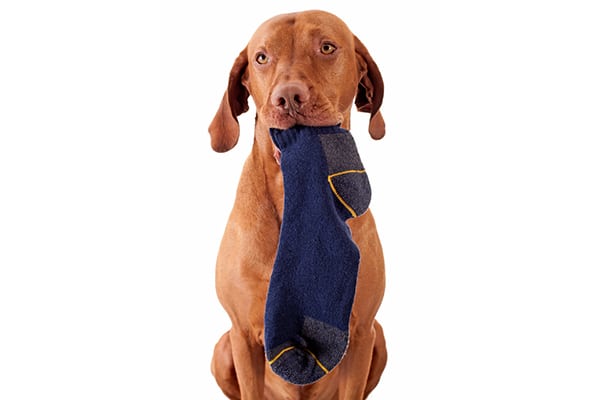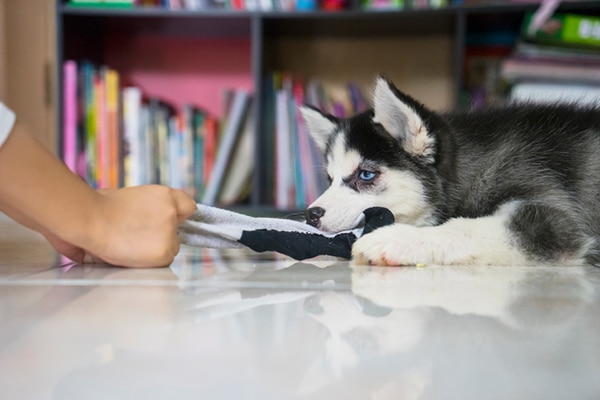The post Dog Surgery Help by Sassafras Lowrey appeared first on Dogster. Copying over entire articles infringes on copyright laws. You may not be aware of it, but all of these articles were assigned, contracted and paid for, so they aren't considered public domain. However, we appreciate that you like the article and would love it if you continued sharing just the first paragraph of an article, then linking out to the rest of the piece on Dogster.com.
Hearing that your dog needs to have surgery can be terrifying and overwhelming even if the prognosis is good that your dog will have a full recovery. Last year when my youngest dog needed to have both her knees surgically rebuilt, I was terrified. But, after doing my research and advocating for my dog, she’s now fully recovered, and I couldn’t be more grateful I moved forward with surgery.
Does your dog need an operation?
If surgery for your dog is being discussed, do your research to make the best decision for your dog and your family. Ask your vet:
- what the prognosis is (forecast)
- what alternatives to surgery might be
- what the surgery will cost
- how invasive the procedure will be
These are the kinds of questions that can help you to make an informed decision about whether surgery is right for your dog.
Getting a second opinion
Heather B. Loenser, DVM, senior veterinary officer at American Animal Hospital Association, explains that the veterinary general practitioners are really “the jack/jill-of-all-trades” and are trained to treat commonly encountered medical and surgical issues, but if you are debating if a surgical procedure is right for your dog, getting a second or third opinion is a good idea. That’s the time to call in the experts — board-certified veterinary surgeons. When determining about moving forward with knee surgery for my dog, my partner and I met with three different board-certified surgeons (in multiple states) before finding a surgeon and hospital we felt comfortable doing the operation.
In addition to getting a second opinion, consult with a veterinary specialist. Founded in 2015 in partnership between the American College of Veterinary Internal Medicine and the American College of Veterinary Surgeons, VetSpecialists.com is a resource for dog owners to find veterinary specialists in your local area without having to rely on a referral. Specialists will be able to walk you through the pros and cons of surgery as well as “conservative management” options instead of surgery, which includes holistic treatment like massage and acupuncture to orthopedic braces.
Patient advocacy
When your dog is going in for surgery you will become his best advocate. It’s completely appropriate to ask the doctor who will be performing the surgery:
- what the risks are for a certain procedure
- how many times he or she has done the procedure
If you don’t feel comfortable with the doctor’s level of experience, it’s OK to find another provider. Interview surgeons, and find someone whom you feel comfortable with.
Make sure to advocate for your dog and find out as much information as possible. Photography by: ©Victoria Rak | Tuff Photo
Dr. Daniel Stobie, founder, chief of staff and veterinary surgeon at NorthStar VETS, advises asking to tour the hospital and surgical recovery center so you have a better understanding where your dog will be. He also suggests bringing your dog for a tour if possible
Dr. Loenser says to ask your dog’s surgeon what mobility will look like post-surgery and if there are any limitations in activity. Also, ask about wound care. Find out what kind of medications your dog will be going home with to decrease risk of infection, anxiety management post procedure, as well as pain management. Dr. Stobie also says that if your dog is on daily medication to check ahead of time if he should get it the night before or morning of surgery and, if so, what dose.
What to do when you just don’t have the cash
It’s a sad fact of life for many dog guardians that the cost is going to factor into decisions about moving forward with surgical procedures. Surgery isn’t cheap. My youngest dog’s surgeries and related rehab costs entered into the five figures. If paying for your dog’s surgery is a concern, there are a few options available:
Payment plans:
Some veterinary practices will allow for guardians to create a payment plan to ease the financial burden of a surgical procedure. Ask your surgeon if that is an option, though know that most veterinary specialists require full payment before the surgery can happen.
Insurance:
Embrace Pet Insurance Claims Manager Rachel Hinder explains that if your dog needs surgery, getting pet insurance right then may not be an option to help cover the procedures. “Unfortunately, by the time it is decided that a pet needs a surgery, that is too late to get pet insurance for that surgery. It is still a great idea to have your pet insured for future conditions, but the reason for that surgery won’t be covered because it is deemed pre-existing. If you already have an insurance policy and your pet needs surgery, you can contact your insurer to do a pre-certification to determine if the surgery would be covered.”
CareCredit:
Many dog owners must put surgical costs on credit cards. If your credit cards don’t have a high enough limit or you are concerned about the interest rate on your cards, CareCredit may be an option. CareCredit is a credit card specifically for paying out-of-pocket veterinary expenses, and your veterinary office will be able to provide you information about how to apply. Boo Larsen, general manager of Veterinary Medicine for CareCredit, explains to Dogster that “To apply for a CareCredit credit card, it typically takes a few minutes for the person to complete a short application in the practice, over the phone (ages 21 and older), online or via mobile. Pet owners will receive a decision within seconds. The office staff can then process charges to the client’s credit card immediately.” Assuming you have the credit.
Scratchpay:
Another option for pet-specific credit is Scratchpay. Neil Stanga, Scratchpay marketing manager, explains that to apply “All you need is a cellphone and access to the internet. Pet parents visit scratchpay.com to begin our 90-second application process. Upon completing the application, they receive an instant approval decision. They can then hit Agree and Submit if they wish to use the plan.” Dog guardians can use Scratchpay funds for any procedures $200 to $10,000. There are three different payment plan lengths:
- Pay Later Plan — 3-month, 0% APR invoice plan
- Pay Over Time Plans – 12-month plan
- 24-month plan, with interest rates varying by client.
Neil explains that not all applicants will be approved for all plans.
Grants:
Some emergency clinics and veterinary hospitals have emergency surgery funding for financially needy guardians. Usually these funds are only available on a case-by-case basis, and after CareCredit has been denied and financial need must be demonstrated.
Crowdsourcing:
We’ve all seen online fundraisers for dogs in need. Sites like GoFundMe make it possible to quickly and easily create a fundraiser to cover medical expenses, but they aren’t dog specific and take a fee out of funds raised.
Waggle has the primary goal of ending economic-driven pet euthanasia by supporting guardians with raising the money to cover veterinary expenses. Waggle’s founder, Steven Mornelli, explains that their approach is unique. “Waggle is the only platform out there that gives the money directly to the veterinary hospital; we never put the money in the hands of the individual or the rescue; the money is paid directly to the veterinary hospitals” so donors can feel secure that their money will actually be going to help dogs in need.
Anesthesia concerns
For many of us the scariest part of our dog needing surgery is knowing that they will be under anesthesia. Dr. Loenser wants dog owners to understand that there are many safety guidelines and procedures that vets and surgeons follow anytime anesthesia is being used. This also includes pre-anesthesia blood work checking for any kind of underlying medical condition, such as diabetes or heart, lung, kidney and liver disease that could lead to complications under anesthesia.
Your dog will need to be without food and water 8 to 12 hours before surgery, to prevent him from vomiting while under anesthesia. During surgery your dog will likely have an IV catheter placed and be intubated to ease with breathing. Dr. Stobie says to ask your surgeon what kind of anesthesia will be used during your dog’s procedure. “There are a lot of new advancements with nerve blocks and epidurals,” he says, “which allows us to numb the hind end if we are doing orthopedic and use lower levels of anesthesia and keeping the animal comfortable.”
Recovery expectations
Consider the type of recovery your dog will have after surgery and be prepared for when your dog comes home. This might look like putting down extra area rugs to provide more traction, and your dog wearing a cone or e-collar while the incision heals. Dr. Stobie also recommends using crates, pens or setting up small areas of the house as recovery rooms for your dog, as well as installing gates on the stairs to keep him from overextending himself.
Preparation is key when helping your dog with recovery. Photography by: ©gollykim | Getty Images
Get a clear understanding of what recovery for your dog is going to look like, create the necessary plans to support your dog and have them in place when your dog comes home. Arrange to have as much time off work as you can, and/or coordinate dog care support with friends and family who can help with watching your dog.
Your dog might also need to spend the night of surgery in the hospital. Dr. Loenser explains that this enables the surgical team to provide round-the-clock monitoring and pain relief to your dog in those critical hours right after surgery. When my dog had both of her knees reconstructed, she spent the night in the hospital for monitoring. Talk with your surgeon about visiting hours — we were allowed to come in the late evening after she’d eaten to visit and sit with her in the recovery room. We also packed her an overnight bag with favorite plush toys from home that stayed with her in her recovery crate at the hospital to make her feel more connected to us.
For many dogs, surgery is just the first step on the road to recovery. Talk to your surgeon about what rehab looks like and look for veterinary rehabilitation certified programs, such as Certified Canine Rehabilitation Practitioner (CCRP) or Certified Canine Rehabilitation Therapist (CCRT).
It sounds cliché, but when your dog needs surgery, knowledge really is power. Ask detailed questions of your veterinarian and/or surgeon to ensure you have all the information.
Thumbnail: ©Victoria Rak | Tuff Photo
About the author:
Sassafras Lowrey is an award-winning author and Certified Trick Dog Instructor. Sassafras’ forthcoming books include: “TRICKS IN THE CITY: For Daring Dogs and the Humans That Love Them,” “Healing/Heeling,” and Bedtime Stories for Rescue Dogs: William To The Rescue. Learn more at SassafrasLowrey.com
Learn more about dog surgery at dogster.com:
The post Dog Surgery Help by Sassafras Lowrey appeared first on Dogster. Copying over entire articles infringes on copyright laws. You may not be aware of it, but all of these articles were assigned, contracted and paid for, so they aren't considered public domain. However, we appreciate that you like the article and would love it if you continued sharing just the first paragraph of an article, then linking out to the rest of the piece on Dogster.com.
Via Dogster https://www.dogster.com



